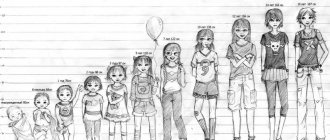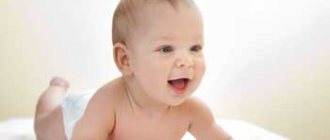Why does an infant constantly twitch his legs and arms?
Although it sometimes seems to us that in the first weeks after birth the baby mostly sleeps and does not move much, this is not so. Trying to adapt to new circumstances and get to know his body, the baby moves his arms and legs.
How do you know when everything is within normal limits and when you should see a doctor?
In the table we have collected the most common reasons why a baby jerks his arms and legs violently
| Increased tone of the limbs | After a long stay in the fetal position, the baby needs some time for the flexor muscles to relax and the extensor muscles to return to their normal physiological state. Therefore, after birth, the baby will constantly move its arms and legs. Movements, as a rule, are bilateral, that is, with two arms or two legs at the same time. By two months everything should be back to normal . If there are deviations, then they speak of decreased or increased muscle tone. In this case, it is necessary to undergo a course of treatment. |
| Function of the digestive system | New food and the associated increased load on the stomach, intestines and other organs leads to discomfort, which is still difficult for the baby to cope with, and this leads to chaotic movements of the arms and legs, which are often accompanied by crying. The baby tries to press his legs closer to his tummy and thereby help digestion, but he cannot fix them, so he jerks them and cries. |
| Colic, gas | In the process of digesting food, babies often experience colic, gas, and tummy pain. Because of this, newborns tighten or, conversely, stretch their legs, twitch their arms and cry. Such conditions, as a rule, disappear by 3-4 months, in some children by 6 months . |
| Pathology of the central nervous system | This is what all mothers are afraid of. Such terrible diagnoses as: encephalopathy, epilepsy, cerebral palsy. In these cases, the baby's movements are very different from the norm and are accompanied by other symptoms. Chaotic eye movements/gazing at one point, protruding tongue, convulsive sucking movements. Such movements are called seizures, and this is a reason to immediately consult a doctor . |
What to do if a child jerks his arms and legs in his sleep?
A full and healthy sleep is necessary for every person.
But this is especially important when it comes to children. After all, a child’s body develops at night.
Therefore, parents are obliged to monitor the quality of their child’s rest.
When a child jerks his arms and legs in his sleep, this may first of all be a manifestation of the immaturity of the nervous system.
A growing body needs sleep. It is especially important for newborns to follow the regime, because in the first months of life, the child begins to adapt to the environment after intrauterine development.
During sleep, important life processes occur in the baby’s body:
- A hormone is produced that is responsible for cell growth. This is important especially in the first year of life. If the body does not have enough resources for growth and formation, this will lead to serious deviations in physical development.
- While awake during the day, the baby receives a lot of new information. And in a dream, the brain sorts the acquired knowledge. Some data later become conditioned reflexes, while others simply remain in memory.
- During sleep, all organs rest: the digestive system slows down, the senses become dull, and the motor system practically ceases to function.
With a lack of sleep, the body begins to work for wear and tear. And this is fraught with consequences, especially for children in whom it has not yet matured.
Sometimes parents notice that their children twitch their arms and legs while sleeping. As a rule, this phenomenon does not cause any inconvenience to the baby. However, we can identify the reasons why this occurs:
- Overwork, including emotional (getting vivid impressions during the day, going on a visit, etc.)
- Teething.
- Intestinal colic, developing against the background of weak intestinal motility, or immaturity of the digestive system. Against this background, increased gas formation develops, and the child jerks his legs in his sleep.
- Children often startle in their sleep while emptying their bladder or bowel.
- Skin rashes and itching.
- A terrible dream, fear of parting with parents or falling.
- Eating large amounts of food before going to bed.
- A child may wince if he or she is in pain.
- A baby may jerk his arms and legs in his sleep at a time when he is experiencing both positive and negative emotions. This usually occurs in the shallow phase of sleep.
If a child flinches occasionally in his sleep, then most likely this phenomenon is not caused by any serious problems. But when twitching of the legs and arms occurs regularly, it is necessary to find out the exact cause of this phenomenon.
When a baby falls asleep, his arms and legs often begin to shake. For a newborn, this phenomenon usually does not cause discomfort. After a few months the trembling goes away.
Sound sleep is important for your baby
Startling at night in children can occur at 2 and 3 years of age. A similar picture is observed in adults. This phenomenon is called hypnotic startle. It is characterized by a sharp contraction of muscles during the process of falling asleep. Therefore, if a child occasionally jerks his arms and legs in his sleep, then there is no need to panic.
If a child has intestinal colic, relief will come when he lies on his stomach. Therefore, if there are such problems, it is better for parents to place the baby in this position about an hour after feeding.
How to ensure a restful sleep for your child?
If a child starts shaking too often during sleep, this becomes a cause for concern for parents. By following certain rules, you can try to avoid this. If your baby's day goes smoothly, he will also sleep well at night. To do this, you need to follow these recommendations:
- Before going to bed, your child can have a light massage. The procedure helps relax muscles and calms you down. Therefore, the baby will fall asleep faster.
- Baths can help you relax if you take them before bed. You can add soothing herbs to the water. Just before doing this, you should make sure that the child is not allergic to them. But sometimes taking a bath can, on the contrary, invigorate the baby. Then it is better to postpone this procedure to the morning.
- In the room where the child sleeps there should not be any foreign objects that interfere with rest. If he has difficulty falling asleep, you can play soothing music before bed that imitates the sound of the sea or raindrops.
- The quality of sleep is affected by the clothes a child wears. Pajamas should be comfortable and not restrict movement.
- The bedroom should always be ventilated before resting.
- You can’t go to bed on an empty stomach, but it’s also harmful to eat beforehand. Therefore, in the evening, a few hours before bedtime, your child can drink a glass of milk or eat fruit.
If parents notice that the child is shuddering in his sleep, they should not wake him up, but rather just stroke him. Then the baby will calm down and the shaking will stop.
When are sleep tremors dangerous?
If a child rarely experiences shuddering at night, then they should not be perceived as something dangerous. But in some cases, this condition can indicate serious health problems.
You should consult a doctor if:
- the child shudders very often at night;
- during the twitch he wakes up;
- legs and arms twitch every night;
- tremors are accompanied by increased excitability, pain and other pathological conditions.
- convulsions appear.
If your child exhibits at least one of the above symptoms, you should contact your pediatrician. If necessary, he will write out a referral to a specialist, for example, a neurologist.
If your child shudders in his sleep, you need to pay attention to:
- frequency of startles;
- their regularity;
- general well-being of the baby.
Using various research methods, it is possible to determine the cause of shuddering in a child during sleep. If he experiences seizures, then diagnosis should be carried out in a hospital setting and include a blood test:
- for hemoglobin;
- biochemical research;
- for phosphorus and calcium content;
- for sugar.
Hardware diagnostics:
- X-ray examination;
- computed tomography (CT) and MRI - only in particularly complex cases;
- Ultrasound of the brain.
Based on the results obtained, a diagnosis is made and treatment is prescribed.
If tremors during sleep are not associated with a disturbance in the functioning of the nervous system, then over time they disappear.
When a child experiences febrile seizures with a high fever, treatment should be directed to the disease that caused the condition. The first step is to reduce the high temperature. Treatment of viral infections in children should be supervised by a pediatrician.
The cause of seizures may be spasmophilia. In the process of treating the disease, it is necessary to take actions aimed at increasing the level of calcium and phosphorus in the blood. For this purpose, special medications are used. Together with them, sedatives and vitamins are prescribed.
As the concentration of calcium and phosphorus in the blood increases, shuddering during sleep will stop. Over time, spasmophilia disappears completely. There are no further consequences due to it.
A more serious cause of tremors during sleep is brain damage during childbirth or as a result of asphyxia. To treat this condition, the neurologist prescribes anticonvulsant therapy. The degree of damage to the nervous system plays a big role here.
In addition to drug treatment, for convulsions the child is prescribed a general massage. For older children, physiotherapeutic procedures such as electrophoresis are performed.
Many children startle in their sleep. As a rule, this phenomenon does not pose a danger to their health. However, if such symptoms appear, it is necessary to carefully monitor the baby during the day and find out what exactly is the cause of this condition. If you suspect a serious illness, you should consult a doctor as soon as possible.
Source: https://momjournal.ru/zdorove-rebenka/detskie-bolezni/rebenok-vo-sne-dergaet-rukami-i-nogami.html
How to help a baby if he jerks his arms and legs a lot?
In order to properly help the baby, you need to establish the exact cause. You should consult a pediatrician, surgeon and neurologist.
- The pediatrician will conduct a general examination and give recommendations on how to improve the functioning of the digestive system, and also refer you to other specialists.
- The surgeon will check your mobility and tummy.
- The neurologist will give his opinion on the baby’s nervous system.
| Massage | An excellent remedy both for colic in the tummy and for relieving muscle tone. If the baby does not have any serious health problems, then the young mother can easily do the massage at home herself. In the case of muscle tone, massage is good to do in the morning and evening after water procedures . Moreover, in the morning it is more intense, alternating stroking and patting with light exercises, carefully bending and unbending the arms and legs, massaging the fingers. In the evening, this can be a light relaxing massage in the form of stroking the back, arms and legs, as well as the tummy. For colic, doctors and experienced mothers advise gently stroking the baby's tummy clockwise for several minutes. |
| Gymnastics | If you have increased muscle tone, you may be prescribed a consultation with a physiotherapist . The specialist will tell you what movements, how and in what sequence should be done so as not to injure the baby. |
| Infant swimming | The procedure itself is very useful, both for children with problems in motor activity and for absolutely healthy children. During water procedures, the heartbeat increases, the blood is saturated with oxygen . Many doctors, answering the question of when you should start swimming with your baby, say: as soon as the umbilical wound heals. Just as in the case of gymnastics, in the morning swimming can be more intense, teach the baby to relax his muscles in warm water, at the end turn on cool water, thereby tempering the baby, and in the evening, simply splashing in warm water with the addition of chamomile infusion, mint, lemon balm or lavender. Pleasant smells will calm the baby and set him up for a sound sleep . |
| Medications | Only after consultation with doctors. If the above methods can be applied, albeit with caution, to all children, then under no circumstances should you prescribe any medications yourself . Many neurologists prescribe very serious drugs for tone, such as Cerebrolysin, Cavinton, Actovegin, etc. For colic, Sab Simplex, Plantex, Dill water, Espumisan are most often prescribed. |
| Physiotherapy | For muscle tone in a newborn, a neurologist may prescribe paraffin and electrophoresis on the legs or arms as physical therapy . |
Of course, no mother wants to think about bad things, but, unfortunately, the statistics are inexorable.
Make an electroencephalogram, neurosonogram. Perhaps, if the examination results are unsatisfactory, the doctor will prescribe magnetic resonance imaging. Or, conversely, the examination results do not reveal pathologies, then the doctor will prescribe nootropic drugs intended to stimulate the nervous system, or sedatives to relieve tension.
Regardless of the test results and doctors’ forecasts, the mother should remain calm. The child’s body is very flexible, most problems can be solved, modern advances in both medicine and pharmaceuticals make it possible to compensate for, and often completely cure, many diseases associated with the nervous system.
Let's look at the tone
The second thing the neuropsychiatrist will look at during the first visit is the state of muscle tone.
In a newborn, the arms are pressed to the body, the fists are clenched, the legs are bent, in general, muscle tone is increased. Up to one and a half months this is the norm. Then the tone should weaken. So the doctor will look at how he became at 3 months: normal (physiological, as doctors say), still elevated or, conversely, decreased.
An experienced neuropsychiatrist will see better than ultrasound whether the infant’s intracranial pressure is normal or increased. The fact is that a difficult pregnancy and complications during childbirth lead to the fact that the brain of first the fetus, and then the baby, does not receive enough oxygen, and as a result, more cerebrospinal fluid is released into the ventricles of the brain than necessary. The ventricles stretch and put pressure on those parts of the brain that are responsible for regulating temperature in the body, for the absorption of food, and for behavior. Babies with increased intracranial pressure may be too excitable - they sleep poorly, scream a lot, and may burp all the time after feeding.
If the fontanel does not bulge, but slightly sinks, if the sutures between the parietal bones and the frontal bone are not too stretched, then everything is fine with the pressure.
To come in
Already registered? Sign in here.
Currently 0 users are viewing
There are no users viewing this page.
Popular Topics
Author: Anna Ptichkina Created 19 hours ago
Author: Ksenia95 Created 18 hours ago
Author: // Elena happy // Created 22 hours ago
Author: Iwanowa Created 18 hours ago
Author: luckyvday_33 Created 5 hours ago
Author: Milaaa Created 1 hour ago
Reviews about clinics
About the site
Quick links
- About the site
- Our authors
- Help with the site
Popular sections
- Forum about pregnancy planning
- Basal temperature charts
- Reproductive Health Library
- Reviews of clinics about doctors
- Communication in clubs on traffic rules
The materials posted on our website are informational in nature and intended for educational purposes. Please do not use them as medical advice. Determining the diagnosis and choosing a treatment method remains the exclusive prerogative of your attending physician!
Many mothers who recently gave birth to their first baby are not only faced for the first time with various difficulties in caring for their treasure, but also with different stages of its development.
This stage of development also includes the period when, at the age of 3-4 months, the baby begins to master new movements, making quick manipulations with its arms and legs. Experienced mothers who have a second, third, or maybe fourth baby are not puzzled by such problems, unlike inexperienced young mothers.
To begin with, you should pay attention to the baby’s developmental stages , his monthly changes in physical and emotional development. From birth, a newborn baby exhibits only reflex movements of the arms and legs, and has the skills of sucking, swallowing, and blinking.
By the end of the first month, the baby begins to actively show his attitude to the sharp sounds and movements around him, he develops a feeling of fear, reflected in the sharp movement of raised arms.
Let's test our reflexes
First of all, the psychoneurologist will look at whether the degree of maturity of the baby’s nervous system corresponds to his age. He determines this maturity by the presence of certain reflexes.
The doctor will press on the center of the month-old baby's palm - the baby will open his mouth. Fine. If he puts his finger into the handle, the baby will grab it. Great, there is a grasping reflex. The doctor will take the baby under the arms and “put” him on the table. If the legs rest on the surface of the table and the baby moves them, as if walking, then there is a reflex of support and automatic walking.
But the same reflex is assessed differently at different ages. For example, if a child “walks” at a month or two, this is good, but at four, it is bad. After two months, the automatic walking reflex should fade.
The doctor will clap his hands - the baby will spread his arms at the sharp sound, and then cross them over his chest. Up to 4 months, such a reflex is the norm, but if it is observed at 6 months, this already indicates that the maturation of the emotional sphere is lagging behind.
At 3 months the baby should be able to hold his head well. If he “pecks” his head when he is picked up, moreover, he shrinks when he is placed on his stomach, this is bad. Such a baby is at risk of cerebral palsy. The doctor will definitely look to see if he has crossed legs. If the legs cross only at the level of the feet, there is nothing wrong; it’s worse if the cross occurs at the level of the hips. Then a neuropsychiatrist must definitely examine the baby at 6 months: by this time, cerebral palsy is almost always already visible.
When to pay attention
Many mothers begin to be especially concerned about such a frisky animation of the baby; at first glance, it may seem that the child is very active and thus shows his character.
Perhaps this can also happen, but more often it happens due to muscle tone . After the birth of a child, every responsible parent, in the first month after the birth of the baby, and every subsequent 3 months, undergoes a commission, which brings together all experienced specialists who carefully check the condition and health of the child. No less important, or even the main such specialist, is a neuropathologist . It is this doctor who will easily determine whether the baby’s active agitation is a manifestation of his temperament, or whether we are talking about muscle tone.
If, after an examination, the doctor diagnoses hypertonicity or hypotonicity, you should not worry too much, but also relax. A neurologist registers such children and closely monitors them during the first year of life.
All newborns, not without exception, are born with muscular dystonia . Decreased or increased muscle tone depends on many factors, including how the birth and pregnancy progressed, as well as how many points on the APGAR scale the baby’s condition was assessed immediately after his birth. Those at risk are primarily premature babies, children born by cesarean section, children with low weight and congenital genetic diseases.
For a baby, muscle tone is the key to his further proper physical development, his emotional and mental well-being. It depends on how quickly the treatment begins and the results will be visible. Muscles in the correct tone help the baby first of all sit down, start crawling in time, stand on his feet, and walk independently.
Hypotonia, on the contrary, shows how poorly a child develops in physical health; more often he is apathetic, not interested in anything, he is prone to obesity, and lags behind his peers in mental development. In addition, muscle dystonia can also indicate intracranial pressure.
Features of newborn development: hypertonicity, regurgitation, sucking and other reflexes
Dmitry Smirnov pediatric neurologist
All parents are concerned about the health of their baby. They look especially closely at the child in the first weeks and months after his birth: is everything okay? If the child is the first, then mothers and fathers may not know about some of the features of its development, and sometimes they are surprised or even frightened by the most ordinary phenomena. What most often worries parents of a newborn?
The child's arms and legs are tense all the time. Maybe it’s hypertension and we need to start some kind of treatment?
Yes, this is hypertonicity - increased tone of the flexor muscles, but this is a completely normal phenomenon that all babies have up to a certain age.
If you look at a newborn, you can see that his arms are bent at all joints, brought to the body and pressed to the chest, his hands are clenched into fists, his thumbs lie under the other four. The baby's legs are also bent at the joints and abducted at the hips; dorsiflexion predominates in the feet. Muscle tone in the arms is usually higher than in the legs.
Attentive parents will notice that muscle tone can change, for example, when turning the head to the side, it is higher on the side opposite the head turn. Changing tone in the same muscle group is called muscular dystonia - this is the name that moms and dads often hear at a neurologist’s appointment, but you shouldn’t be afraid of this, this is also a completely common phenomenon in infants.
By 3.5–4 months, physiological hypertonicity in children weakens , movements become more coordinated, the hand opens, so-called locomotion develops - body movements in which almost all muscle groups are involved. There is no need to treat physiological hypertonicity , but you can do a restorative massage, it will contribute to the development of the muscular system and coordination of movements.
The baby is constantly making some movements, they are very chaotic. Why is this happening?
A newborn baby's nervous system is still immature, which is why he cannot make coordinated movements. The baby’s nerve fibers are just beginning to be covered with a special myelin sheath, which is responsible for the speed of transmission of nerve impulses to the muscles. The faster the transfer occurs, the smoother the baby’s movements become. Until the nervous system has matured, a small child may be in constant motion, which sometimes persists even in sleep.
As a rule, chaotic twitching disappears in the second month of life. Then the movements of the arms and legs gradually become more even and orderly.
The child’s arms, legs, and chin are trembling—maybe he is cold or has some kind of neurological disease?
Shaking, or tremor, is a physiological phenomenon that occurs in most children in the first 3 months of life.
Tremor appears again due to the immaturity of the nervous system. Trembling usually occurs while crying or after some kind of exertion (for example, after swimming), but sometimes it begins quite suddenly, perhaps even at rest. When a child has tremors, the chin and lower lip usually tremble, and the arms and legs may also tremble.
Tremor can be symmetrical (both arms tremble) and asymmetrical, when different parts of the body tremble separately (for example, the chin and arms or one arm and one leg tremble at the same time).
As soon as parents notice that the baby has a tremor (and it may not appear immediately after birth, but even a month later), they are very worried. However, as we have already said, this is normal in young children. Nevertheless, you need to pay attention to the following points: physiological tremor does not last long - only a few seconds; if the tremor intensifies, the episodes become more frequent and longer, you need to show the baby to a neurologist.
The baby often shudders and throws his arms to the sides. Is this normal or should I take my child to the doctor?
This is a manifestation of one of the innate reflexes - the so-called Moro reflex (spreading the arms followed by bringing them together). It lasts up to 4-5 months and usually occurs in response to sharp sounds or when changing body position. Parents call this reflex a startle.
Moms and dads notice that if you change the baby’s position in space (for example, lift him out of bed and then put him back down), the baby will throw his arms slightly bent at the elbows up. The same can happen with any sharp sound (clapping hands, knocking on a door). Sometimes the Moro reflex occurs spontaneously, that is, the baby throws up his arms without any stimuli. All these phenomena are completely normal for young children and do not require any treatment . The only thing you need to watch out for is that the Moro reflex should not become more pronounced; after 4–5 months it should disappear.
The child constantly wants to suck (pacifier, breast, finger). Maybe he's hungry and doesn't have enough milk?
In children under 1 year of age, the sucking reflex is pronounced: in response to any irritation of the lips or tongue, the child makes sucking movements. This is the very first and most important unconditioned reflex: it is the ability to suck (and therefore satisfy hunger) that ensures the baby’s survival . The sucking reflex completely disappears only by 3–4 years.
Even in infants, you can notice a search reflex (it lasts up to 2–4 months): when the corner of the mouth is irritated, the baby turns its head in the direction of irritation; proboscis reflex (this can be observed up to 2–3 months): when the child taps his lips, he stretches out his lips with a tube. Before eating, these reflexes appear brighter and are easier to evoke, but in themselves they are not an indicator that the baby is hungry.
The baby spits up a lot, I heard that this could be due to neurological disorders. Is it so?
Regurgitation is a very common complaint in the first months of life. Most healthy children burp up to 3-5 times a day. For infants, regurgitation is the norm rather than a pathology , since the structure and functioning of the gastrointestinal tract predispose them to regurgitation.
The stomach of newborns is located horizontally, has a round shape and a small volume - only 5-10 ml: this is why a few drops of colostrum are enough for a newly born baby to eat. The entrance to the baby's stomach is relatively wide, and the sphincter (the muscle that closes the entrance to the stomach) is underdeveloped. Therefore, the movement of food through the gastrointestinal tract is somewhat slower.
Correction of tone
The main thing parents should do is monitor the development and emotional state of the child. As a rule, drug treatment is required in exceptional cases; basically, all treatment consists of proper and professional baby massage . It is a professional massage therapist who can easily determine where the baby’s problem areas are and take up his treatment.
You need to entrust the health of your baby to an experienced, and first of all, children's massage therapist, because a massage can not only help, but if not done correctly, it can cause harm. The manipulations performed with the baby's arms, legs and movements on his delicate skin give direct impulses that enter the cerebral cortex and central nervous system, after which the correct functioning of the muscles is activated.
Light strokes on the baby's arms, legs, and back can be done by the baby's mother at home. Such exercise will not only invigorate the child, but also give him a pleasant tactile sensation.
swimming is an effective remedy against muscle tone . This could be a swimming pool, individual lessons with a children's specialist, or soothing baths with a set of various herbs, such as chamomile, motherwort, and a general herbal mixture.
Movement is the main thing in the life of a little man and its main function. The correct development of a baby is the key to its psycho-emotional state. Be healthy.
Motor reactions.
During wakefulness, a “revival complex” often and easily arises. The child wiggles his legs and arms, showing animation and joy. Raises his legs up and quickly straightens them. Supports its weight by resting its legs on the support. Lying on your stomach, lean on your forearms, maybe, resting your hands on the mattress, slightly raise your torso. Turns on its side on its own.
Skills.
During feeding, holds the mother's breast or bottle with her hands. When he sees his mother’s breast, he reaches out and grabs it with his hands. During feeding, does not remove hands from bottle or breast.
Hand movements.
He examines, feels and grabs the toys hanging low over his chest, stretching out both hands and pulling the toys into his mouth. The emergence of grasping is a very important stage in the development of a baby. Expresses joy when new toys appear. Tactile sensitivity develops, which is important for the occurrence of the act of grasping and examination.
From 4 to 7 months, effective actions arise: moving objects, moving them, extracting sounds from them.
Visual reactions.
Recognizes mother or loved one and smiles joyfully. He looks at the stranger calmly. Distinguishes between flat and
volumetric images. Follows the toy for up to 3 minutes or more in all directions.
Auditory reactions.
He listens to the sounds of a voice, music, or a playing toy, looks for the source of the sound, and clearly turns his head towards it. Looks at him for 10 seconds. Reacts differently to calm and dancing melodies. He calmly listens to a lullaby and perks up at the sounds of a dance song. Distinguishes the voices of loved ones from the voices of strangers. The mother's voice connects with her face.
Speech reactions.
He hums on his own after eating, when falling asleep and after communicating with adults after 1-3 minutes. Repeatedly pronounces vowel sounds, emits enthusiastic screams, and plays with the sounds that he makes with the help of saliva. A melodious hum is clearly expressed.
Emotions.
The child laughs with all his heart, out loud. For the first time, the child begins to respond to tickling: the effectiveness of tickling depends on whether the baby is aware that another person is doing it. Until 3.5 months, the child is not able to recognize another person.
He is interested in everything that happens around him and looks around. He responds with a smile. He looks for another child, reaches out to him, tries to touch him.
• A 4-month-old child is a creature with a developed visual-motor system and good general auditory abilities.
• He is able to control the movements of his arms and legs, but still has difficulty controlling his trunk.
• There is a reaction to novelty.
• The baby sleeps all night long.
• Gives parents a real smile and laughs out loud.
• A child at this age becomes round, elastic and unusually beautiful.
• boy’s weight – 6000-6900 g
• girl’s weight – 5500-6400 g
• boy’s height – 62-64 cm
• girl’s height – 61-62 cm
Intelligence.
The third stage of development of sensory intelligence begins (from 4 to 8 months) - the implementation of purposeful actions. The child begins to distinguish between cause and effect: if you pull the ring, the bell will ring, if you press the switch, the light will go out.
A four-month-old baby has certain patterns of its parents' faces. He will look for a long time at a graphic or sculptural image of a face with eyes located in place of the mouth, but will briefly linger his gaze on the image of a face without eyes at all. This suggests that minor changes in an object or phenomenon are much more attractive to an infant than complete novelty.
At 4 months, the reaction to novelty is manifested in the duration of holding the gaze on a new object.
First attachments.
Try standing near your baby without looking at him. He will first smile, look expectantly, wait a little, and then, most likely, begin to twist his arms and legs.
If you refrain from returning a smile or glance, which is very difficult to do, then the baby may still try to induce you to respond with inviting sounds that turn into dissatisfied intonations, or even whimpering; Resentment is also possible - the child will turn away.
If a four-month-old baby does not react in this way in the proposed situation, but simply does not pay attention to you - and this is repeated several times at other moments of wakefulness - this is a signal: the child does not show initiative in communication.
If he himself is passive despite your passivity, you can be sure that this is the result of your attitude towards the child, which does not develop and does not reinforce his own initiative, the result of your incorrect organization of communication with him.
How to assess the physical development of a child from 0 to 3 months?
The material in this and subsequent articles on the development of a child in the first year of life will be of interest to those parents who want to take responsibility for the health of their baby.
From the moment a baby appears in your family, you will probably come across the opinion that only specialists (pediatricians, child neurologists and orthopedists) can determine how healthy and developed your child is, only a professional massage therapist can do massage and gymnastics correctly, only an instructor in swimming will be able to practice early swimming with him.
I believe that in the event of the birth of a healthy child, it is enough for his mother to have good information about child development and about different methods of teaching a newborn, as well as the desire to master them herself and apply them in practice.
And for a baby there is nothing better than a mother’s hands and voice addressed to him with love.
In the case of the birth of a sick child, professional treatment is, of course, necessary, but the active involvement of parents in the healing process is also necessary.
This material is about the development of a healthy baby and what parents can do with their baby to help this development.
Conditions for classes
First, let's discuss the conditions under which it makes sense to evaluate a child and work with him. The room chosen for these purposes should be quiet, evenly heated, with a temperature of approximately 26-29C.
The baby should be undressed and lie on a fairly hard surface (this could be a changing table or just a sofa covered with a foam rubber mat). The best time is an hour and a half after the last feeding.
What does a newborn look like?
So, before us is a newborn baby - in the first 6 weeks of life . Let's look at what he looks like lying on his back, on his stomach and in an upright position.
Supine position
The child's posture is unbalanced; you see that he moves his head, arms and legs chaotically. At the same time, the hands are clenched into fists, the arms are bent at the elbows, and the legs are spread outward.
The baby's head does not stay in the middle position, turning without preference either to the left or to the right. If you put your thumbs in your baby's hands, he will squeeze them.
Holding his forearms with your hands, lift the child slightly above the surface, you will see that his head will tilt back.
Prone position
A healthy newborn turns his head to the side (with a one-way light source, mainly in one direction) and can lift it sideways for a moment. The arms and legs are completely bent, the hands are clenched into a fist, the knees are pulled under the stomach.
If the baby does not remain in a resting position, then reflexive crawling movements are visible. An adult can cause such movements by lightly pressing the thumb on the foot. This leads to extension of the legs and movement of the body forward. Try stimulating your left and your right foot alternately and evaluate the same force of reaction on both sides.
These photos clearly show how our children have grown up and learned a lot: they lie confidently on their backs, the movements of their arms and legs are no longer chaotic. Babies begin to learn coordinated movements: hand-mouth, hand-foot.
Vertical position
Hold your baby under the armpits with both hands and position him upright, allowing his feet to touch the surface. At the same time, support the head with your thumbs in the middle position, turn the child’s back towards you.
A healthy newborn in this position demonstrates a “primitive leg support response.” The legs of a vertically held baby straighten, the tone of the knee joints increases, and to a lesser extent the hip joints; straightening of the whole body and a short raising of the head are possible.
The entire foot touches the surface, the arms are bent, the palms are clenched into a fist.
If you tilt the child’s torso slightly forward, you can observe an “automatic stepping movement” - the baby will alternately perform stepping movements with his legs.
This is what a healthy baby looks like during the first 6 weeks of life. In the future, it will develop thanks to the program invested in it by nature itself.
The main task of the first three months, if you remember (if not, look at the article Motor development of a child in the first year), is mastering a new environment, which is completely different from the space of the uterus in which the baby developed over the previous 9 months.
Each child is unique, so the pace of achieving this goal will naturally vary. However, keep in mind that the next approximate time point when you should evaluate the development of your child is 3-3.5 months.
The child twitches very often during the day
During consultations, moms and dads ask: “ Why does the child twitch so much ? What
what to do if a child’s cheek and face, shoulder and arm, leg or whole body twitch? Where to go if the boy starts to twitch? Where to treat a girl if she twitches and screams, shouts words and moans, swears? Which doctor should you consult for twitching?”
Unfortunately, some parents do not immediately turn to a medical institution, but wait until the twitching goes away on their own, or believe in folk methods and methods. But in vain! This is the main mistake of moms and dads. Instead of starting treatment at an early stage, they wait for the process to progress.
I see mom!
A psychoneurologist will check how your baby reacts to light, sound, and a person’s face.
At one and a half months, the baby should, at least for a minute, keep his gaze on the person who is leaning towards him. At this age complexes of attention and imitation already appear. The mother bends over to her child, lifts his head, talks to him, and the baby looks at her intently. He sees a talking mouth and also opens his mouth and even tries to imitate something with his lips.
At 2 months, the child should already be following objects that move in front of his eyes, reacting to sound and light: you clapped - he shuddered, blinked, you brought a flashlight to his face - he closed his eyes. He can already turn his head towards the source of light and sound, understand where, from which side the sound is coming, the light is falling.
How is emotional development going? The doctor will also determine this at the first examination.
In a month and a half, a response smile appears. Some semblance of a smile could have flashed on the baby’s face before, but it was not a conscious emotional reaction, but rather a grimace, the ability to portray which is inherent in nature. Now he smiles at a human face. True, he will open his mouth and smile not only when his mother bends over him with a gentle coo, but also if you show him a human face painted on a piece of paper or a balloon. He will smile at the doll too. But only up to 4 months. With a silent mask, a four-month-old baby can flirt: shake his head, babble, smile, call for communication. And if there is no reaction, he will get angry and cry. Good job! Since you can’t fool him with a mask, it means he’s growing up and developing correctly.
Reasons why a child twitches
There are various reasons why a baby starts twitching. When can a boy or girl twitch? In a dream, in the morning, during the day, in the evening, at night. More often in the afternoon, in the evening the twitching intensifies. Involuntary twitching is provoked by stress, high mental and mental stress, positive or negative emotions. The causes are psychological trauma, infectious and somatic diseases, and diseases of the nervous system.
One of the common and serious reasons why a baby begins to twitch is Tourette's syndrome.
Tourette's syndrome , or Gilles de la Tourette's disease, is also called a disease of compulsive tics. Tourette's syndrome is characterized by the appearance of motor, so-called motor tics. This may include cheek twitching, left or right eye twitching, eye rolling, or neck twitching. Later, tics of the whole body, jerking of the left or right hand or tics of both hands, tic-like movements of the leg or legs are added. But Tourette syndrome is not limited to motor tics alone. Chronic motor single, more often generalized tics begin to be combined with vocal, that is, sound tics. How does this happen? The child begins to utter sounds sporadically. Sometimes he hums, grunts, chokes, as if barking, sobs, shouts out individual syllables or words, repeats the same word several times (echolalia). As Tourette's disease progresses, shouting of obscene words and swearing (coprolalia) appear. Vocal tics usually appear much later than motor tics appear. In a few months or even years.
In these cases, reasonable questions arise: “Why does a 5-year-old child twitch strongly, does his leg or arm, cheek or eye, torso or body twitch? What to do and how to treat if a 6-year-old child twitches in his stomach in his sleep, his eye twitches while studying, his legs twitch strongly and often when he falls asleep? How to treat a 7-year-old baby if his leg or arm or head twitches, the baby cries, screams, often wakes up during sleep, jerks sharply during feeding? Who treats if a child’s shoulder twitches strangely and horribly, his legs and fingers twitch involuntarily and spontaneously during sleep and while he is awake, he twitches while sitting or standing? If your child has freezing, tension, clenching of hands, twitching of the muscles of the face, arms, legs, neck, torso, chin, whole body, hyperkinesis, squinting, rapid blinking, grimacing, turning the head and eyes up and to the left (right) and shaking , jerking shoulders, clasping hands with involuntary bending, general tension, redness of the face, twitching of the body, when walking or standing, throwing forward and to the side of the foot with circular movements, jumping, dancing, vocalisms, contact Sarklinik. If your guy or girl grunts, grunts, grunts, spits, screams sharply loudly with the sound “A”, he has emotional instability, aggressiveness and self-aggression, be sure to consult a doctor. Neurosis of obsessive movements, chronic motor generalized tics, Gilles de la Tourette syndrome need to be treated comprehensively.
"AiF Health" recommends
For the first meeting with a psychoneurologist, the mother needs to prepare - think about what worries her, what worries her in the baby’s behavior. She should tell the doctor:
1. How the baby sleeps.
Newborns should sleep 16–18 hours a day. But their sleep can be superficial, with endless awakenings at night and early morning awakenings. The dream is still immature, its rhythm has not formed. And yet, if the baby has trouble falling asleep, confuses day and night, or sleeps little, you should definitely tell a neuropsychiatrist about this.
2. Does he cry a lot?
During the first month of life, a newborn is in a bad mood. If he doesn’t sleep, he cries, with a grimace of displeasure on his face. And this is understandable. Having transferred from intrauterine existence to our world, the baby experienced severe stress, and now he needs to adapt to a lot: both to a new way of eating - breastfeeding (and there are still few enzymes in the stomach, food causes discomfort in the stomach), and to independent bowel movements, and to the ambient temperature, and to the air, and to the noise around. In short, how can you not cry? But an endlessly and unreasonably screaming baby should alert the mother.
3. Is he eating well?
A child’s refusal to breastfeed is also a reason to talk to a neuropsychiatrist. This may simply be a reaction to the stress of childbirth, or it may be a symptom of more serious neurological problems.
4. How is his pre-speech development going?
By one month, the baby makes the first guttural sounds. By one and a half months, vowel sounds appear - melodies. At 2 months the baby begins to walk. At 4 – sing in the morning as soon as he wakes up. If this evolution of sounds exists, development is proceeding correctly. If the child is silent and does not make any sounds, the pre-speech stage of development is disrupted; a neuropsychiatrist must be told about this.
5. Does he have a “revival complex”.
At 2 months, the baby should smile when his mother appears. At 3 months - smile, wave your arms and kick your legs. At 4 – smile, wave, and even squeal. Even the appearance of toys can cause such delight. And this is good. After 6 months, the “revival complex” fades away.
Treatment of Tourette's syndrome in Russia, Saratov
Sarklinik provides comprehensive treatment for Tourette syndrome in Russia, Saratov. 12 basic and 20 additional techniques are used, which in most cases allow you to get rid of vocal and motor tics, involuntary tic-like movements, grunting, shouting, twitching of the face, neck, arms and legs, and torso.
Sign up for a consultation. There are contraindications. Specialist consultation is required.
Information about treatment at the Sarclinic:
Questions from parents about Gilles de la Tourette syndrome: 1, 2, 3, 4, 5, 6, 7.
You have some kind of mess in your head. %)
jerking, regurgitation, mixed feeding. %)
twitches his legs. how should it lie? standing at attention and not moving or what?
When I was feeding my son at your age, I held his arms, legs and bouncing butt :gy:
There can be a lot of reasons for regurgitation, but you chose the most implausible one.
Do you spit up after every feeding? do you hold it upright? why mixed feeding?
Do you feed while lying down? Your baby seems to be active. try carrying and feeding in your arms, or somehow distracting with toys-rattles - so that there are fewer body movements
It is possible, of course, that he is spitting up due to the fact that (as you put it) he is messing up the food :gy:
Well, well... he doesn’t pump as always and the baby is capricious.
Try squeezing the arms and legs in turn while feeding. take the handle in your palm, gently squeeze it, do this several times, then the other handle, then the legs in turn. Both of mine calmed down from such massages and jerked less.
When you hold it in a column, does it regurgitate air?
How did you guess that there was not enough milk? or who suggested? :nose:
Even if you lay it out before eating, does it still spit up?
after eating, if you don't need to put it on your stomach
why is there not enough milk? Because mixed feeding











